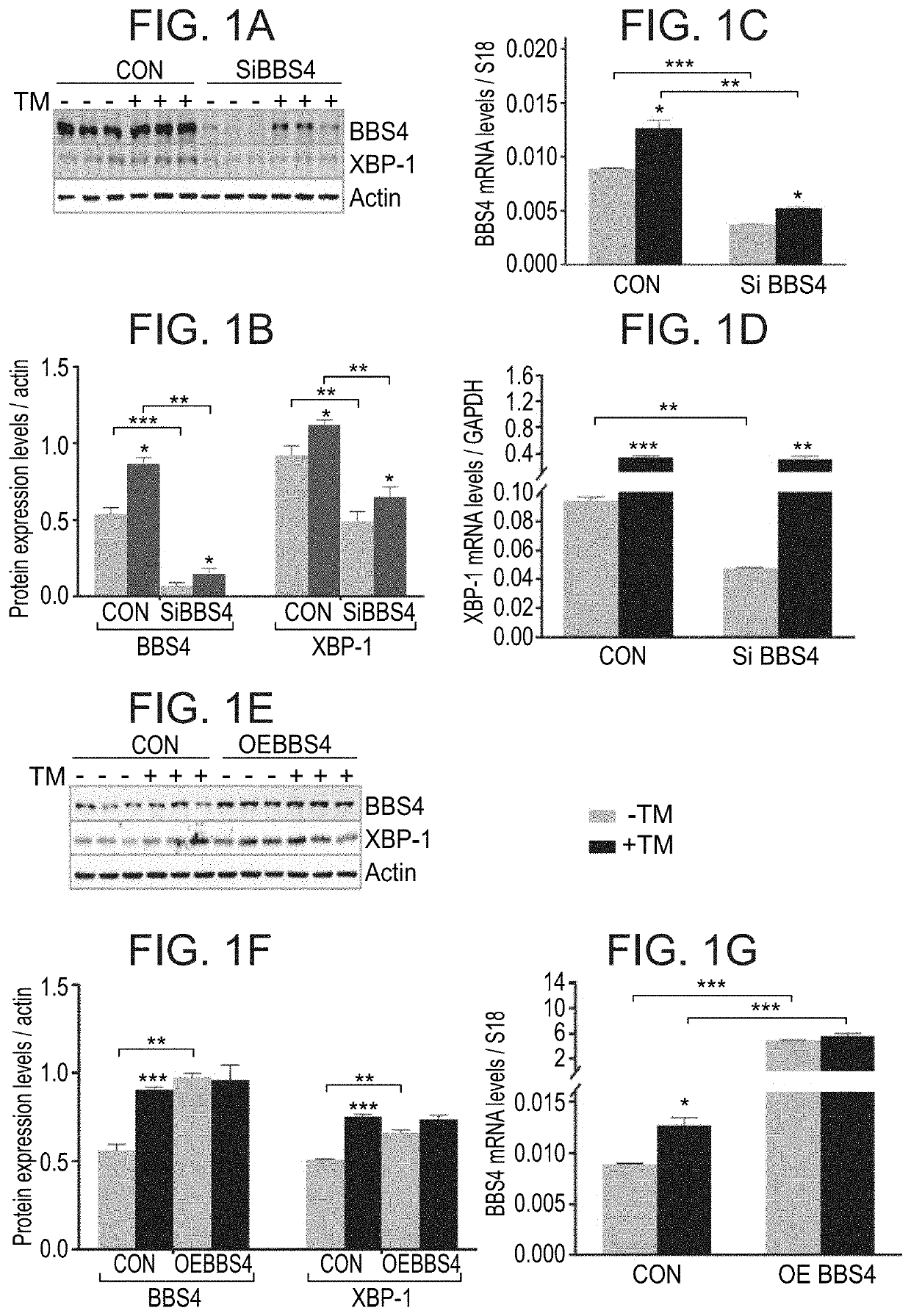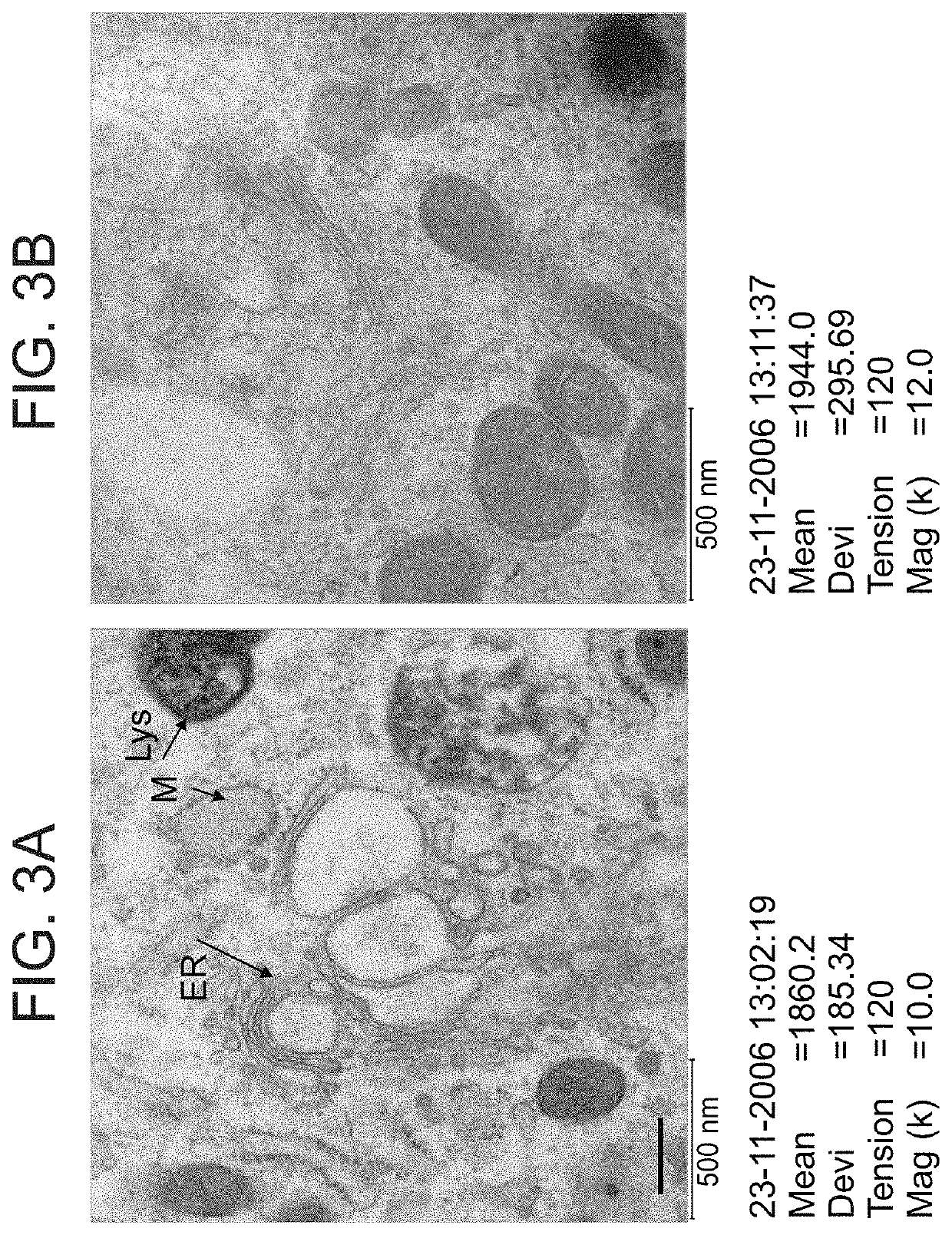Methods of treating diseases associated with cells exhibiting er stress or with neural tissue damage
- Summary
- Abstract
- Description
- Claims
- Application Information
AI Technical Summary
Benefits of technology
Problems solved by technology
Method used
Image
Examples
example 1
BBS4 Expression and Localization is Responsive to Er Stress (Using Adipocytes as a Model)
[0341]To study the role of BBS4 in endoplasmic reticulum (ER) stress induced unfolding protein response (UPR), murine preadipocytes were subjected to ER stress using Tunicamycin (TM) during in-vitro adipogenesis.
[0342]BBS4 expression is up-regulated under ER stress—Previous studies have shown that transcript levels of BBS4 (as well as other BBS genes) were significantly altered through adipocytes differentiation, reaching maximum levels at day 3(17). TM induced ER stress resulted in a significant increase in BBS4 protein and transcript levels by 1.6 and 1.3 (P<0.05) fold, respectively, at day 3 of adipogenesis, as compared to un-treated control (FIGS. 1A-D). As expected, over-expression of BBS4 (OEBBS4) (FIGS. 1E-G) resulted in a significant elevation in both BBS4 protein (p<0.001) and transcript (p<0.05) levels by 400 and 1.8 fold, respectively, compared to control cells; while downregulation o...
example 2
Down-Regulation of BBS4 Affects Er Stress Induced Unfolding Protein Response (Using Adipocytes as a Model)
[0344]BBS4 silencing affects cells' morphology—TEM analysis of SiBBS4 adipocytes at day 8 of in-vitro differentiation demonstrated an exceptionally large amount of lysosomes and autophagic vacuoles containing cytoplasmic organelles in various states of autolysis (FIGS. 3A-B). These vacuoles, were described in differentiating 3T3-L1 cells as early as 1980 and may reflect the dramatic remodeling that accompanies differentiation. SiBB4 cells also contained more, larger in size and swollen ER indicative of ER stress compared to control cells (FIGS. 3A-B).
[0345]BBS4 silencing down-regulates XBP-1 expression levels—XBP-1 is crucial UPR transcription factor subjected to transcriptional and post-translational regulation. XBP-1 transcript levels during adipocytes differentiation (day 0, 1, 2, 3, 5, 8) was determined in control, SiBBS4 and OEBBS4 cells. In control adipocytes, XBP-1 transc...
example 3
Down-Regulation of BBS4 Affects Er Stress Induced Unfolding Protein Response (Using Neuronal Cells as a Model)
[0366]Neural differentiation is characterized by early ER stress manifested by UPR activation. Hence, the role of BBS4 in UPR activation during in-vitro neural differentiation of human SH-SY5Y Neuroblastoma cell line was studied.
[0367]BBS4 silencing down-regulates XBP-1 expression, XBP-1 splicing and CHOP expression during neuronal differentiation—XBP-1 is crucial UPR transcription factor subjected to transcriptional and post-translational regulation. XBP-1 transcript levels during neuronal differentiation (day 0, 1, 3, 5) was determined in control and SiBBS4 cells. In both siBBS4 and control SH-SY5Y cells, XBP-1 transcript and protein levels were significantly (P<0.05) higher at early differentiation days (0-1 days), with significant reduction as differentiation progressed. In comparison to mature cells (day 5), XBP-1 levels in undifferentiated cells were significantly lowe...
PUM
| Property | Measurement | Unit |
|---|---|---|
| volume | aaaaa | aaaaa |
| pH | aaaaa | aaaaa |
| volume | aaaaa | aaaaa |
Abstract
Description
Claims
Application Information
 Login to View More
Login to View More - R&D
- Intellectual Property
- Life Sciences
- Materials
- Tech Scout
- Unparalleled Data Quality
- Higher Quality Content
- 60% Fewer Hallucinations
Browse by: Latest US Patents, China's latest patents, Technical Efficacy Thesaurus, Application Domain, Technology Topic, Popular Technical Reports.
© 2025 PatSnap. All rights reserved.Legal|Privacy policy|Modern Slavery Act Transparency Statement|Sitemap|About US| Contact US: help@patsnap.com



